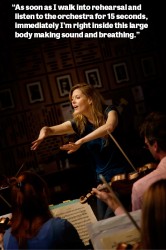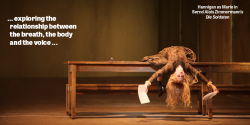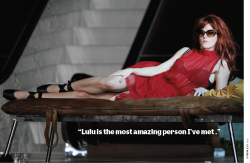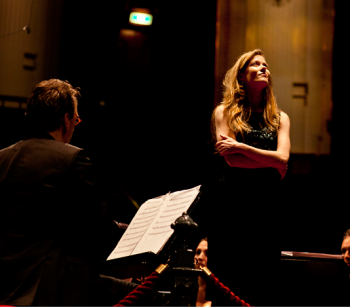 Being the music. This is how Canadian-born soprano and now conductor Barbara Hannigan describes her approach to performing. Two questions come to mind: How does one do this? And what are the ingredients needed to so completely embody the music as to become it? George Meredith’s words from his poem The Lark Ascending that inspired Ralph Vaughan Williams’ work of the same name suggest one answer: “The song seraphically free, Of taint of personality, So pure that it salutes the suns.” Hannigan herself gives a hint when she states: “I’m happy with my performance when I know I’ve made the connection between breath and sound, when the whole body is singing.”
Being the music. This is how Canadian-born soprano and now conductor Barbara Hannigan describes her approach to performing. Two questions come to mind: How does one do this? And what are the ingredients needed to so completely embody the music as to become it? George Meredith’s words from his poem The Lark Ascending that inspired Ralph Vaughan Williams’ work of the same name suggest one answer: “The song seraphically free, Of taint of personality, So pure that it salutes the suns.” Hannigan herself gives a hint when she states: “I’m happy with my performance when I know I’ve made the connection between breath and sound, when the whole body is singing.”
Fourteen years ago the then Toronto-based Hannigan appeared on the cover of The WholeNote magazine. At the time she was performing the lead role in the operetta The Merry Widow and her European career was beginning to take off. Now living in Amsterdam, with bookings four to five years in advance, she is returning to Toronto as the featured performer at this years’ New Creations Festival presented by the Toronto Symphony. In three concerts scheduled between February 28 and March 7, Hannigan will be performing both Canadian and North American premieres of works by British composer George Benjamin and Danish composer Hans Abrahamsen.
As is evident in that WholeNote article back in December 2000, she was already well known as a perfomer who was versatile, flexible, able to immediately grasp the music and who could sing a wide range of vocal timbres throughout an extended pitch range, something often called for by contemporary composers. She attributes this in part to her Canadian musical education – the excellent programs she experienced as a child in Nova Scotia, her classical singing training with Mary Morrison at the University of Toronto and her work with Richard Armstrong exploring the relationship between the breath, the body and the voice. She also acknowledges that her ability to penetrate deep into the heart of a piece comes from a special connection she has with music. “With most pieces I can get inside fairly quickly and find the key. It’s partly due to having done it for 25 years, but even when I was young, I loved it. That was the game I wanted to play – to get past the technical demands and go right into the dramatic aspects because that’s what carries to the audience. It’s the core of the piece that we want to hear, the expression of the composer’s soul.”
 Her ability to dive in and take risks was recognized early on by Morrison. “Mary always said I was driven, and I didn’t really know what that meant at the beginning. But now I know – it’s this centrifugal force that is constant. I feel that I have almost an obligation toward a lot of the repertoire I sing. Even if the piece wasn’t written for me, I know that when I sing contemporary pieces such as Claude Vivier’s Lonely Child, Quatre chants pour franchir le seuil by French composer Gérard Grisey, or Pli selon pli by Pierre Boulez (a lifetime high when I performed it with Boulez conducting in 2011), it opens doors and helps those pieces find their destiny. That’s how I feel about my work – that I’m helping those children find their life, grow into adulthood and be present in the world hopefully.” She’s so successful in this mission that she’ll be performing Vivier’s Lonely Child with the Vienna Philharmonic this coming year. “Can you imagine,” she says, enthusiastically. “The Vienna Philharmonic agreed to perform Lonely Child! Bringing this kind of repertoire to that level and to an audience not used to hearing this kind of music – to me, those are the important things.”
Her ability to dive in and take risks was recognized early on by Morrison. “Mary always said I was driven, and I didn’t really know what that meant at the beginning. But now I know – it’s this centrifugal force that is constant. I feel that I have almost an obligation toward a lot of the repertoire I sing. Even if the piece wasn’t written for me, I know that when I sing contemporary pieces such as Claude Vivier’s Lonely Child, Quatre chants pour franchir le seuil by French composer Gérard Grisey, or Pli selon pli by Pierre Boulez (a lifetime high when I performed it with Boulez conducting in 2011), it opens doors and helps those pieces find their destiny. That’s how I feel about my work – that I’m helping those children find their life, grow into adulthood and be present in the world hopefully.” She’s so successful in this mission that she’ll be performing Vivier’s Lonely Child with the Vienna Philharmonic this coming year. “Can you imagine,” she says, enthusiastically. “The Vienna Philharmonic agreed to perform Lonely Child! Bringing this kind of repertoire to that level and to an audience not used to hearing this kind of music – to me, those are the important things.”
For Hannigan, the through line in her career has been the repertoire. “I’m repertoire driven. It’s always been about what I want to sing, not where or even with whom, although that figures in very strongly now. There are certain conductors such as Esa-Pekka Salonen and Sir Simon Rattle with whom I have a very strong relationship and can suggest repertoire. In fact Rattle has become a good musical partner. About six years ago, he asked me for a wish list. That’s when I told him I wanted to do Lonely Child by Vivier. It’s always been about the repertoire.”
When I asked her in our recent interview if she approached the performance of concert works and operatic roles differently, she stated: “I don’t think of playing a role anymore, it’s just BEING the music. I’m being that music, whether its concert or opera. For example, last week when I was performing the opera excerpts –Three Fragments from Berg’s opera Wozzeck, and Mysteries of the Macabre from Ligeti’s opera Le Grand Macabre, I became those two characters. I didn’t play or interpret Marie or Gepopo, I just WAS them.
“The act of performing has become for me an act of witnessing. Not only does this include the music as it is on the page, but also the experience of the character, my own experience, the voice of the composer, all the performers. both on stage or in the pit, and the audience. We are all involved in this act of witnessing. It’s as if every performance is in the round, whether it’s concert or opera. I use the word witnessing because it’s like a ritual we’re involved in as opposed to a performance. Live performance is so special, it’s a sacred thing. Even if I’m feeling the stress of my day, as soon as I walk into rehearsal and listen to the orchestra for 15 seconds, immediately I’m right inside this large body making sound and breathing.”
Earlier in Hannigan’s career, she worked extensively with teacher, director and performer Richard Armstrong, who began his career in the late 1960s as a member of the Roy Hart Theatre. One of the exercises Hannigan cited as playing a pivotal role in her training was Richard’s ball exercise. Imagine a group of 12 to 15 people running around the room all connected to a large Pilates ball. The one person who has possession of the ball is making a sound, while everyone else has their hands on the ball. Their job is to physically embody the sound as if they were making the sound without actually vocalizing it. When the ball gets passed to another, the new ball-holder’s body is already experiencing the sound, thus making it an effortless transition between being silent and becoming the soundmaker. Hannigan says this exercise stuck with her very strongly. “It doesn’t matter if I’ve been silent for 20 minutes, I’m still resonating with everybody else and I know who’s got the ball. I didn’t know what to call it back then, all I knew was this is the way I wanted to make music. And that’s why I started conducting. Because I was feeling so deeply the fullness with everyone, when it was suggested to me by Radio France that I should explore conducting, I thought yes, lets try.”
 Her conducting debut was in 2011 at the Théâtre du Châtelet in Paris where she conducted Renard by Stravinsky as master conductor Esa-Pekka Salonen sat listening in the audience. “It was a really exciting moment for me. Conducting presents a new depth of entering into the score. Now I have to be responsible – I call it the ‘parental feeling.’ As a singer I can be more childish and playful, but as a conductor I need to be an adult. I went out and did it! The next morning, the phone started ringing and it was orchestras wanting me to come and make special programs where I would sing about 30 percent of the program and conduct 70 percent.” The exciting news
Her conducting debut was in 2011 at the Théâtre du Châtelet in Paris where she conducted Renard by Stravinsky as master conductor Esa-Pekka Salonen sat listening in the audience. “It was a really exciting moment for me. Conducting presents a new depth of entering into the score. Now I have to be responsible – I call it the ‘parental feeling.’ As a singer I can be more childish and playful, but as a conductor I need to be an adult. I went out and did it! The next morning, the phone started ringing and it was orchestras wanting me to come and make special programs where I would sing about 30 percent of the program and conduct 70 percent.” The exciting news
for Toronto audiences is that Hannigan will be making her Canadian conducting debut with the Toronto Symphony this coming fall on October 7 and 8. She’ll be singing Djamila Boupacha, a work for soprano by Luigi Nono, and conducting Haydn’s Symphony No.49 “La Passione,” three arias by Mozart, Ligeti’s Concert Românesc and Stravinsky’s Symphony in Three Movements.
During our conversation about her rising career as a conductor, she pointed to an August 2014 article written for the New York Times by James Oestreich. “He notes that I wear a dress when I conduct and that my arms are bare. If you’re a woman and you conduct, you get asked ‘What’s it like to be a woman conductor?’ I was never asked that question as a singer – what’s it like to be a female soprano. There’s no gender question at all. All of a sudden I move into a field that’s male dominated and it’s a huge gender issue.”
“At first I dismissed the question. But then I decided that those questions were very important for a lot of people on many different levels. I do wear a dress just to the knees and my arms are bare, because my arms are one of my most expressive tools. For my debut I wore a suit because I thought I had to, it was the convention. But I felt bound. Why dress like a man? I need to be free, I need to move. So I changed how I dressed and decided not to look mannish. I wanted to just be me. The same me that sings and the same me that conducts an orchestra. And why should it be any different? This decision was incredibly moving not just for the audience, but also for the players, men and women alike. It was like taking off that suit of tradition and saying it’s too heavy, we don’t need this anymore.”
When Hannigan made her Dutch conducting debut at the Concertgebouwin 2013, the sold-out concert generated such a wave of excitement about a female singer conducting the orchestra that people were even sitting on the stage. The concert began with her performance of Nono’s Djamila Boupacha, a piece about a persecuted female Algerian freedom fighter. As the piece ended, instead of allowing the audience to applaud, she turned to the orchestra who were already on stage, and started conducting Haydn’s Symphony No.49 as if the symphony was a passion for Boupacha. “After the performance, both men and women were hugging me and were very emotional. I’m positive it wasn’t just because it was a good concert, but rather something had changed for them that they didn’t know was possible. They hadn’t seen it, just like I had never seen a woman conduct an orchestra when I was a kid.”
When it comes to performing female characters such as Lulu in Berg’s opera of the same name, Marie in Wozzeck, Donna Anna in Mozart’s Don Giovanni or the character Agnès in Benjamin’s Written on Skin which she’ll be performing at the New Creations Festival, her approach is to move beyond understanding these women through the lens of traditional stereotypes such as femme fatale, victim or hysteric. “I have never seen those characters that way,” she says. “Lulu is the most amazing person I’ve met, with a very strong inner voice, extremely honest, and run by her own instinct. In Written on Skin set in 12th-century Provence, Agnès liberates herself from an oppressive marriage by choosing an illicit affair. Caught in an impossible situation with no freedom to have her own voice, her eventual suicide becomes a triumph. She chooses her own destiny rather than be enslaved or killed by an outraged husband.
Hannigan’s sensitivity to portraying strong female characters comes to the fore in another work being performed at New Creations. let me tell you, a work she commissioned through the Berlin Philharmonic, became an opportunity for her to work collaboratively with composer Abrahamsen and writer Paul Griffiths. The texts are from Griffiths’ novel of the same name, written using only the words Shakespeare gave to Ophelia. The book is a retelling of all that has happened in Ophelia’s life since she died in Hamlet. “When I perform the piece, my back story is about all the women who have found their voices over the last 400 years. Now we have a new Ophelia, and even though she retains the personality of the young Shakespearian Ophelia, she’s now found her own words.”
Barbara Hannigan is an astonishing presence, a change-maker on many levels: bringing contemporary sounds and composers to new audiences; cutting through the glass ceiling in classical orchestral conducting; reshaping traditional female roles into characters of strength; designing unique orchestral programs that combine singing with conducting; and commissioning new works that give voice to the contemporary female psyche. All the while “being the music” so committedly that her entire self embodies the spirit of the sounds she serves. She will leave their mark on music-making well into the future.
Wendalyn Bartley is a Toronto-based composer and electro-vocal sound artist.
 Discography
Discography
The following is a year-by-year discography of Barbara Hannigan’s 15 recordings (CDs and DVDs):
2006
Writing to Vermeer: Louis Andriessen; Asko-Schönberg Ensemble; Reinbert de Leeuw, conductor. Nonesuch Records (USA): 79887-2.
Rinaldo:G.F. Handel;Aradia Baroque Orchestra; Kevin Mallon, conductor. Naxos CD: 8.660165-67.
2008
Etymo: Luca Francesconi; IRCAM Ensemble Intercontemporain; Susanna Mälkki, conductor.Kairos CD: KAI0012712.
Symphony No. 4: Mahler; Toronto Symphony Orchestra;Peter Oundjian, conductor.TSO Live/Toronto Symphony Orchestra.
2009
Sables, Oxygéne: Bart Visman; Limburgs Symfonie Orkest; Ed Spanjaard, conductor. Etcetera CD: KTC1378.
2010
Polish Masterpieces: Ebony Band; Werner Herbers, artistic leader; Barbara Hannigan is featured in Die Liebe, Cantata Op.14 (1931) by Jozef Koffler. Channel Classics: CD: CCS 31010.
The House of the Sleeping Beauties: Kris Defoort; Asko-Schönberg Ensemble; Patrick Davin, conductor. Fuga Libera CD: FUG 708.
2012
Requiem:György Ligeti; WDR Sinfonieorchester Köln; SWR Vokalensemble Stuttgart; WDR Rundfunkchor Köln; Peter Eötvös, conductor.
Le Grand Macabre: György Ligeti; Orquestra Simfònica i Cor del Gran Teatre del Liceu; Michael Boder, conductor; Àlex Ollé (La Fura dels Baus) and Valentina Carrasco, stage direction. Arthaus Musik DVD 101643 (NTSC); Blu-ray 108058; Budapest Music CD & DVD: BMC CD 166.
2013
Correspondances: Henri Dutilleux; Orchestre Philharmonique de Radio France; Esa-Pekka Salonen,conductor. Deutsche Grammophon CD: 0289 479 1180 7 CD DDD GH.
Awards: Gramophone Best Contemporary Recording 2013; Victoires de la Musique Classique Best Recording 2014.
Written on Skin: George Benjamin; Mahler Chamber Orchestra; George Benjamin,conductor. Nimbus Records CD: NI5885. Awards: BBC Music Magazine Premiere Recording of the Year, 2014.
Les Illuminations: Benjamin Britten; Amsterdam Sinfonietta; Candida Thompson,leader & violin. Channel Classics CD: 32213.
Awards: Audiophile Audition Best Disc of the Year.
2014
Written on Skin: George Benjamin; Orchestra of the Royal Opera House; Royal Opera Chorus; George Benjamin, conductor. Opus Arte DVD: OA1125D; Blu-ray: OABD7136D. Awards: Gramophone Awards 2014, winner Contemporary.
The Importance of Being Earnest: Gerald Barry; Birmingham Contemporary Music Group; Thomas Adès,conductor. NMC Recordings CD: NMC D197.
Awards: Gramophone Magazine, Editor’s Choice, October 2014.
Lulu: Alban Berg; Orchestre Symphonique de la Monnaie; Paul Daniel, conductor; Krzysztof Warlikowski, stage direction. Bel Air Classiques DVD: BAC 109.



